*We are a reader-supported website. When you buy through links on our site, we may earn a small affiliate commission at no extra cost to you.*
Introduction
Embarking on a new teddy bear crafting project is always an exciting endeavor. Whether you’re a seasoned teddy bear artist or a novice crafter, choosing the right stuffing material is crucial for creating the perfect cuddly companion. In this comprehensive guide, we’ll explore the top 10 options of teddy bear stuffing material, covering everything from polyester fiberfill to traditional wooden stuffing.
1. Polyester Fiberfill
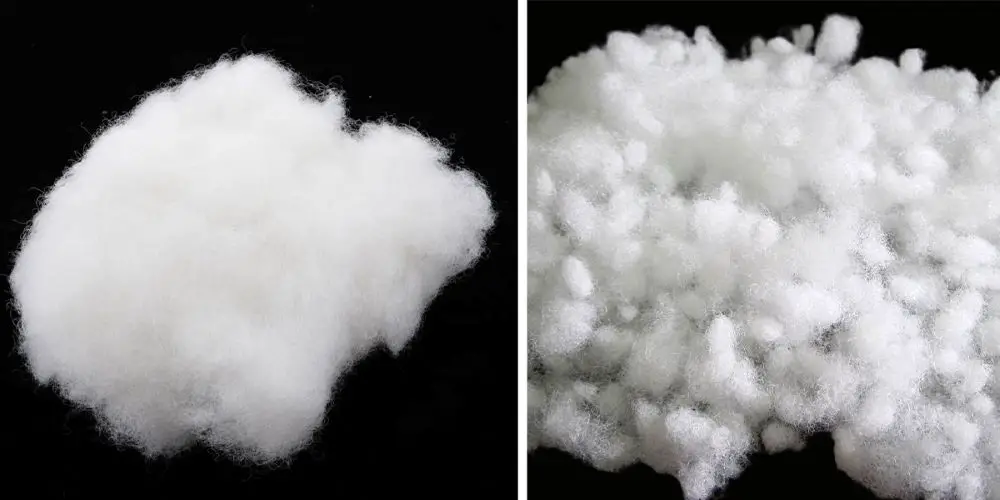
Polyester fiberfill is a widely used stuffing material in the world of teddy bear crafting, cherished for its softness, affordability, and hypoallergenic properties. This synthetic material offers several advantages, making it a popular choice for both beginners and experienced crafters alike.
To stuff a teddy bear with polyester fiberfill, simply fill the bear’s body cavity with small amounts of fiberfill at a time, ensuring even distribution for a smooth and consistent finish. For best results, avoid overstuffing, as this can lead to a stiff and unnatural-looking bear.
Pros:
- Soft and lightweight: Polyester fiberfill provides a plush and huggable texture to teddy bears, ensuring they are irresistibly cuddly.
- Affordable: Available at most craft stores and online retailers, polyester fiberfill is a cost-effective option for teddy bear stuffing.
- Hypoallergenic: Ideal for individuals with allergies or sensitivities, polyester fiberfill is free from common allergens such as dust mites and pet dander.
- Easy to wash: Polyester fiberfill is machine washable, making it perfect for crafting stuffed toys for children. It can withstand regular washing, ensuring the teddy bear remains clean and hygienic for years to come.
Cons:
- May compress over time: With frequent handling and use, polyester fiberfill may gradually lose its loft and shape, requiring occasional fluffing to maintain the desired plushness.
- Synthetic material: Some crafters prefer natural stuffing materials for their projects, and polyester fiberfill is not biodegradable like cotton or wool.
- Some brands could be expensive
Polyester fiberfill is readily available for purchase at craft stores, fabric shops, and online retailers such as Amazon, Etsy, and eBay. Crafters can choose from a variety of brands and package sizes to suit their specific project needs.
2. Cotton Stuffing
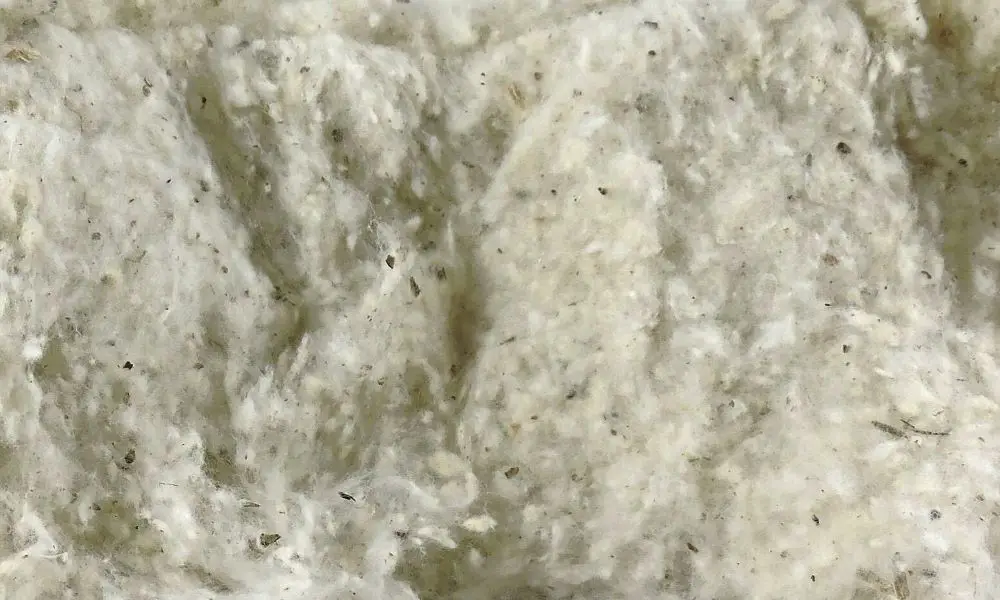
Cotton stuffing is a beloved option among teddy bear makers, valued for its natural feel, breathability, and versatility. This eco-friendly material offers several advantages, making it a popular choice for crafters seeking a traditional stuffing option for their projects.
To stuff a teddy bear with cotton stuffing, gently fill the bear’s body cavity with small amounts of stuffing at a time, ensuring even distribution for a soft and cuddly finish. Take care not to overstuff, as this can lead to a stiff and unnatural-looking bear.
Pros:
- Soft and breathable: Cotton stuffing provides a firm yet gentle texture to teddy bears, giving them a classic and timeless appeal.
- Eco-friendly: Made from natural fibers, cotton stuffing is biodegradable and environmentally sustainable, making it an excellent choice for eco-conscious crafters.
- Hypoallergenic: Suitable for individuals with allergies or sensitivities, cotton stuffing is free from synthetic additives and common allergens.
- Easy to work with: Cotton stuffing is easy to manipulate and shape, allowing crafters to achieve the desired look and feel for their teddy bears.
Cons:
- May compact over time: With regular use and handling, cotton stuffing may gradually compress, requiring occasional fluffing to maintain its loft and softness.
- Requires occasional fluffing: Unlike synthetic materials, cotton stuffing may need periodic fluffing to restore its plushness and shape.
- May degrade over time: Like all natural materials, cotton stuffing may degrade and lose its shape over time, leading to a decrease in plushness and resilience.
- Potential for seam leakage: Due to its natural fibers, cotton stuffing may gradually protrude from seams, especially with frequent use and handling. Regular maintenance and stitching may be required to prevent seam leakage and maintain the integrity of the teddy bear
- May be more expensive: Compared to synthetic alternatives, high-quality cotton stuffing may be more expensive.
Cotton stuffing is readily available for purchase at craft stores, fabric shops, and online retailers such as Amazon, Etsy, and eBay. Crafters can choose from a variety of brands and package sizes to suit their specific project needs.
3. Wool Roving
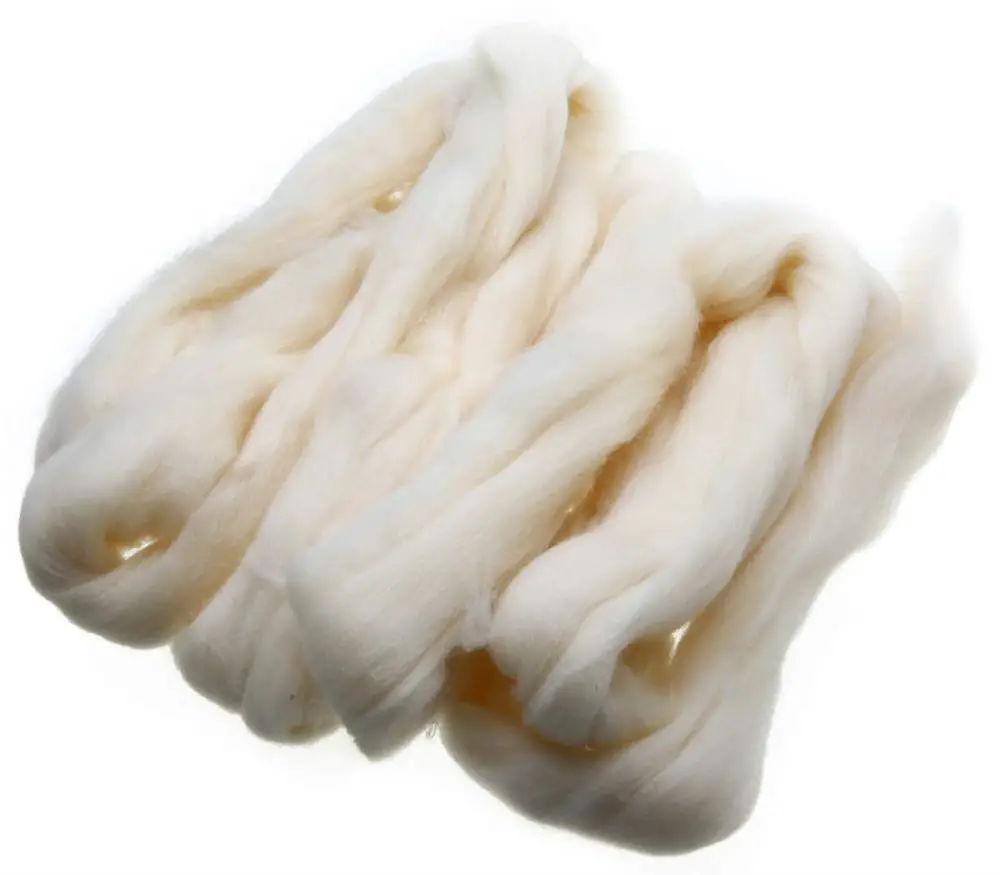
Wool roving is a luxurious stuffing material derived from natural sheep’s wool, prized for its warmth, softness, and versatility.
Crafters appreciate wool roving for its ability to provide excellent loft and structure to teddy bears, resulting in plush and cuddly creations. However, like any material, wool roving has its own set of pros and cons.
Pros:
- Warm and soft texture, ideal for creating cozy teddy bears.
- Highly resilient, maintaining its shape and loft over time.
- Offers creative possibilities, allowing crafters to sculpt intricate details and textures.
- Naturally hypoallergenic, suitable for individuals with sensitivities to synthetic materials.
Cons:
- Not suitable for individuals with wool allergies.
- May require special care and handling to prevent felting or matting.
- Can be more expensive compared to synthetic stuffing materials.
- Limited availability in some regions, may require sourcing from specialty suppliers.
To stuff a teddy bear with wool roving, gently fill the bear’s body cavity with small amounts of roving at a time, ensuring even distribution for a plush and cuddly finish.
Take care to avoid overstuffing, as this can lead to a stiff and unnatural-looking bear. Wool roving is available from specialty suppliers and online retailers, offering crafters a high-quality and natural option for their teddy bear projects. Also, you can find it online from retailers such as Amazon, Etsy, and eBay.
4. Poly Pellets
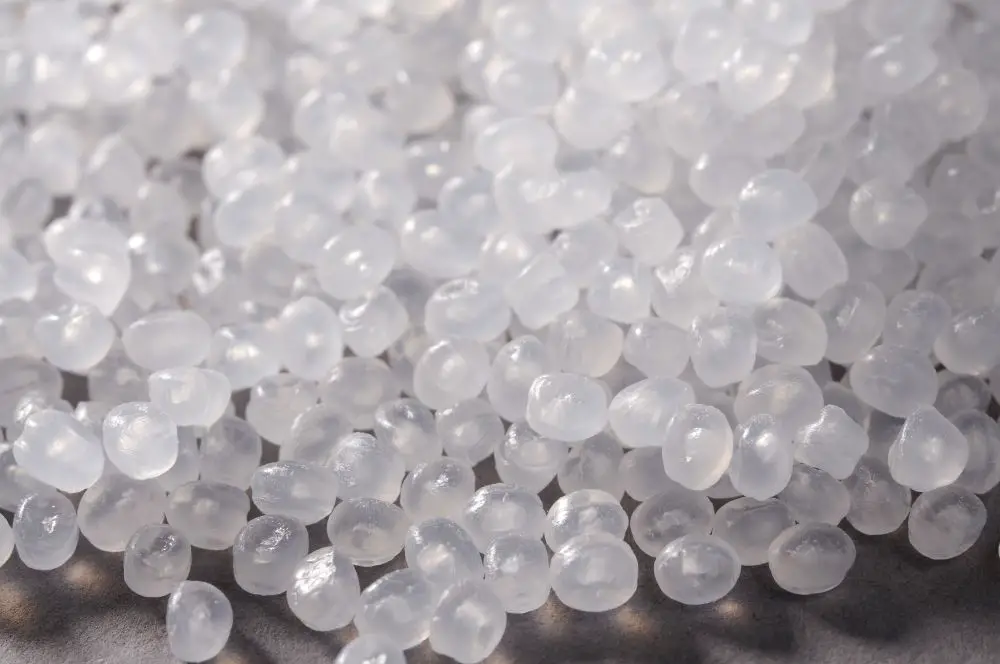
Poly pellets, also known as plastic pellets, are a versatile stuffing material commonly used to add weight and stability to teddy bears and other stuffed animals.
Crafters appreciate poly pellets for their ability to provide a lifelike feel and enhanced durability to plushies. However, like any material, poly pellets come with their own set of pros and cons.
Pros:
- Adds weight and stability to teddy bears, making them feel more substantial and lifelike.
- Customizable density, allows crafters to adjust the weight of their creations to suit their preferences.
- Safe and non-toxic, suitable for use in children’s toys when properly secured.
- Resistant to moisture and mildew, ensuring the longevity of the finished plushie.
Cons:
- Potential choking hazard if not properly secured within the bear’s body.
- Requires careful containment within a sealed inner bag or pouch to prevent leakage.
- May be more expensive compared to traditional stuffing materials.
- Not biodegradable, contributing to environmental concerns about plastic waste.
To stuff a teddy bear with poly pellets, carefully fill the bear’s body cavity with the desired amount of pellets, ensuring they are securely contained within a sealed inner bag or pouch. Take care to evenly distribute the pellets for a balanced weight distribution.
Poly pellets can be purchased from craft stores, online retailers, and specialty suppliers, offering crafters a durable and customizable option for their teddy bear projects.
You can purchase poly pellets on various online platforms including Amazon, Etsy, and eBay. These platforms offer a wide selection of poly pellets from different brands and sellers, allowing crafters to find the perfect option for their projects.
Additionally, you can often find bulk quantities of poly pellets at competitive prices, making it convenient to stock up for multiple teddy bear projects or other crafting endeavors.
5. Microbeads
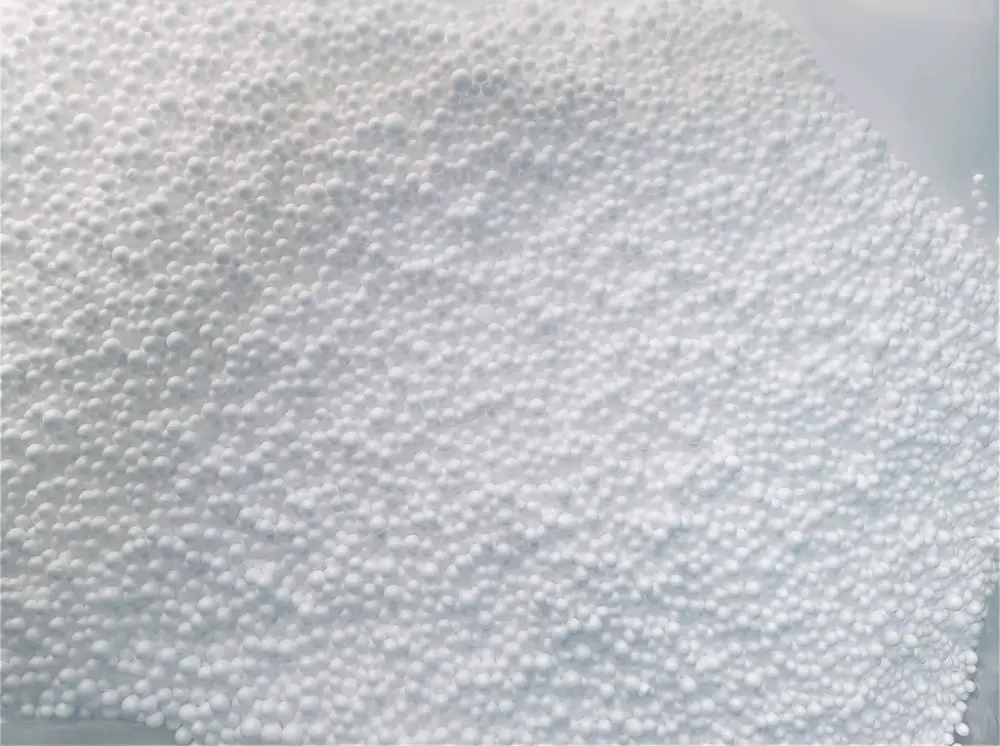
Microbeads are tiny spherical beads made from plastic or synthetic materials, commonly used as a stuffing material for teddy bears and other stuffed animals.
Crafters appreciate microbeads for their smooth and lightweight texture, which provides a unique tactile experience to plushies. However, like any material, microbeads have their own set of pros and cons.
Pros:
- Smooth and lightweight texture, giving teddy bears a squishy and malleable feel.
- A versatile material that can be mixed with other stuffing materials to achieve specific textures and densities.
- Available in various sizes and colors, allowing crafters to customize the look and feel of their creations.
- Resistant to moisture and mildew, ensuring the longevity of the finished plushie.
Cons:
- Environmental concerns due to their non-biodegradable nature, contribute to plastic pollution.
- Potential for health hazards if ingested by children or animals, requiring careful containment within the bear’s body.
- Limited availability compared to traditional stuffing materials.
- Higher cost compared to other stuffing materials.
Microbeads can be purchased from various online platforms including Amazon, Etsy, and eBay.These platforms offer a range of options from different sellers, allowing crafters to find the perfect microbeads for their projects.
6. Bamboo Fiber
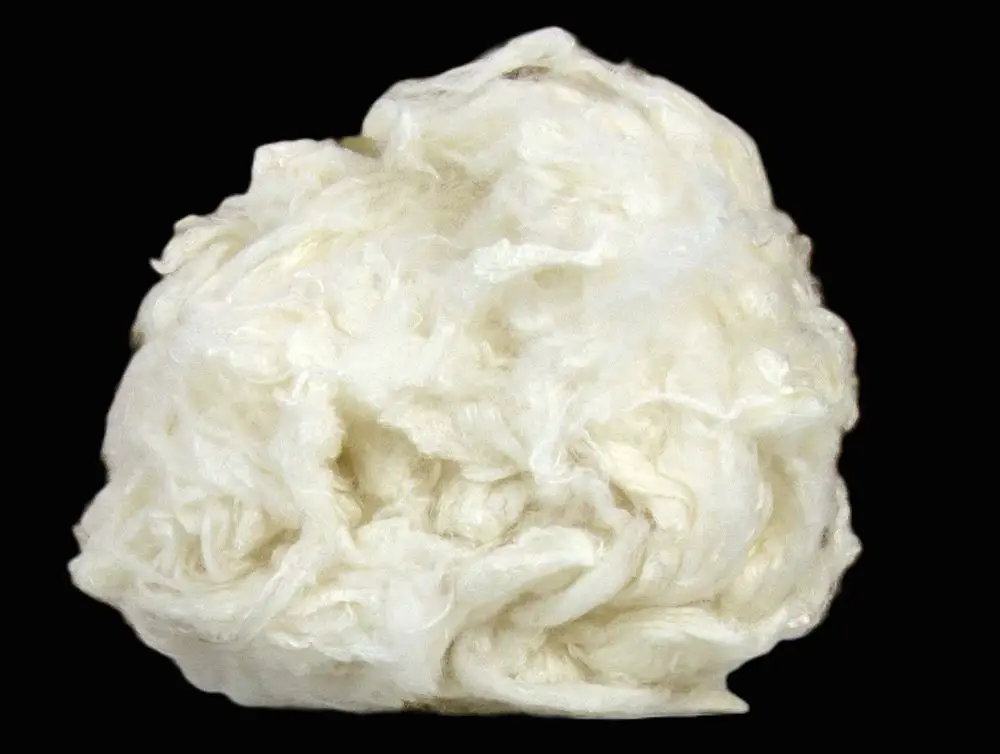
Bamboo fiber is a sustainable and eco-friendly stuffing material derived from bamboo plants, prized for its unique properties and environmental benefits.
Crafters appreciate bamboo fiber for its excellent loft and resilience, making it ideal for creating plush and cuddly teddy bears. However, like any material, bamboo fiber has its own set of pros and cons.
Pros:
- Sustainable and renewable resource, making it an eco-friendly choice for environmentally conscious crafters.
- Naturally hypoallergenic and antibacterial, suitable for individuals with sensitive skin or allergies.
- Soft and breathable texture, providing a comfortable and cozy feel to teddy bears.
- Resilient and durable, maintaining its shape and loft over time.
Cons:
- Limited availability compared to traditional stuffing materials, may require sourcing from specialty suppliers.
- Higher cost compared to synthetic alternatives.
- Requires careful handling and storage to prevent moisture absorption and mold growth.
- May not be suitable for individuals with bamboo allergies.
Bamboo fiber can be purchased from select online platforms including Amazon, Etsy, and eBay. These platforms offer a range of options from different sellers, allowing crafters to find the perfect bamboo fiber for their projects.
7. Kapok Stuffing
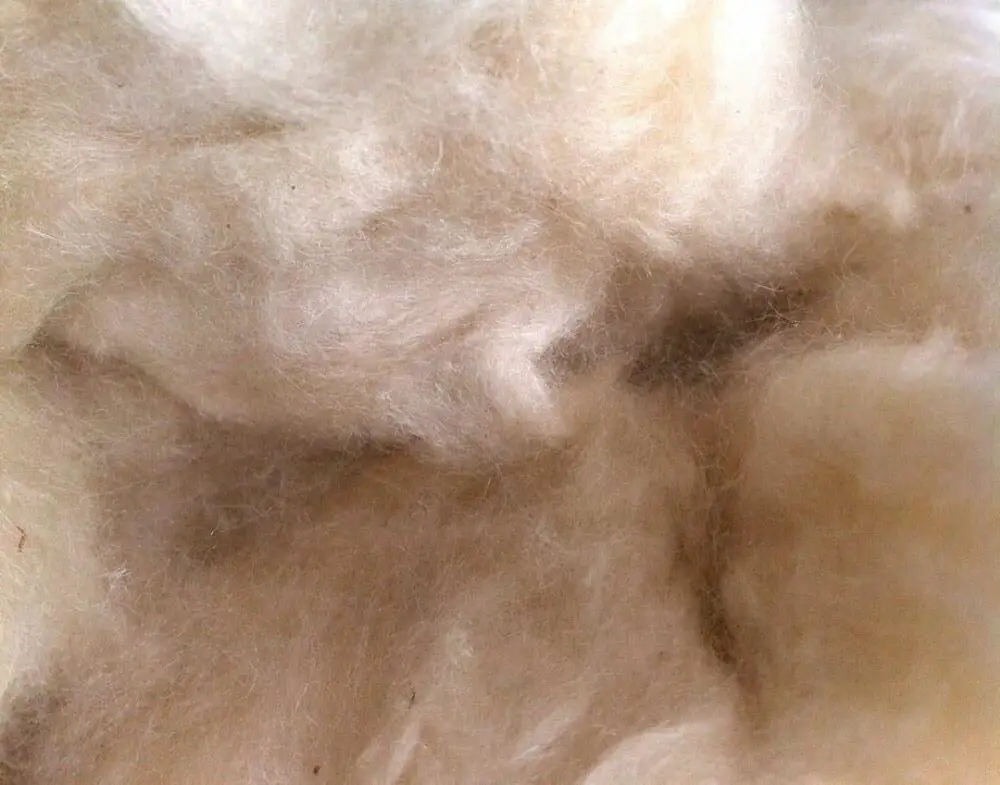
Kapok stuffing, derived from the seed pods of the kapok tree, is a natural and sustainable stuffing material prized for its lightweight and buoyant properties.
Crafters appreciate kapok stuffing for its soft and airy texture, making it ideal for creating teddy bears with a light and fluffy feel. However, like any material, kapok stuffing has its own set of pros and cons.
Pros:
- Naturally hypoallergenic and resistant to mold and mildew, making it suitable for individuals with allergies or sensitivities.
- Soft and airy texture, providing a plush and cuddly feel to teddy bears.
- Lightweight and buoyant, giving teddy bears a light and airy feel without added bulk.
- Sustainable and eco-friendly, as kapok trees require minimal resources to grow and harvest.
Cons:
- May compress over time, requiring occasional fluffing to maintain its loft and softness.
- Limited availability compared to synthetic stuffing materials, may require sourcing from specialty suppliers.
- Higher cost compared to traditional stuffing materials.
- However, it requires careful handling and storage to prevent moisture absorption and mold growth, as these conditions can be problematic for any organic material.
Kapok stuffing can be purchased from select online platforms such as Amazon, Etsy, and eBay, although availability may vary.
8. Organic Cotton Batting
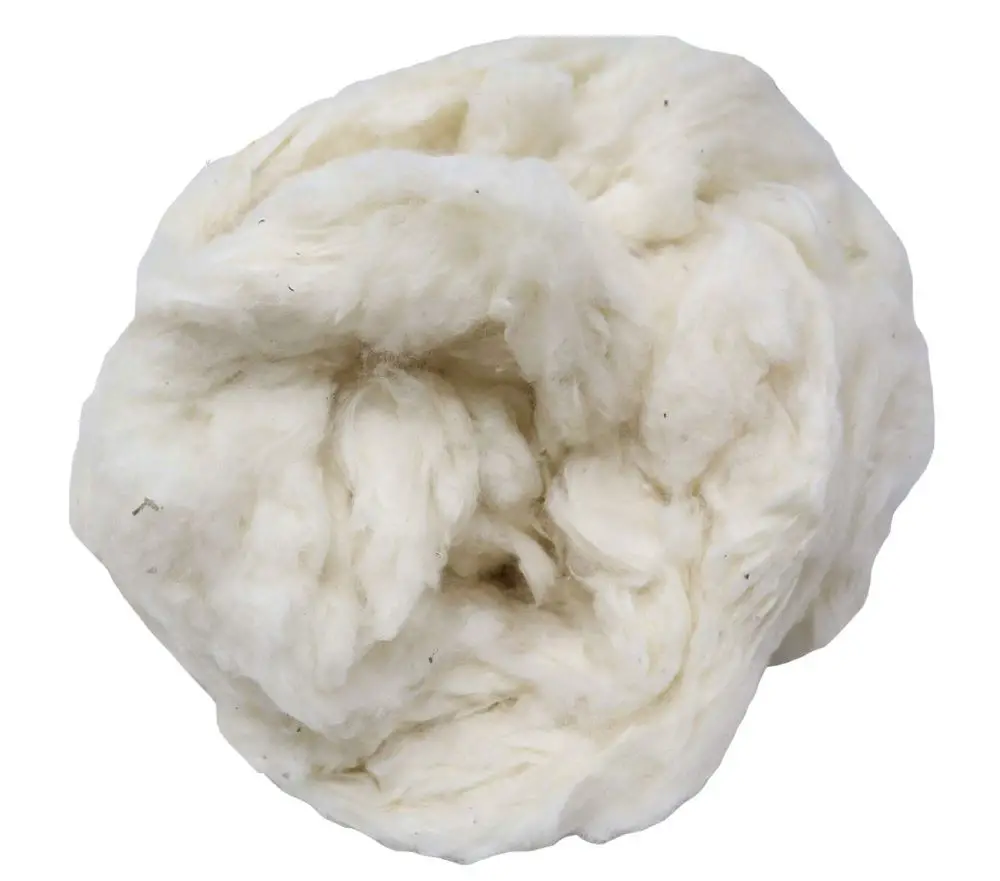
Organic cotton batting is a natural stuffing material made from organic cotton fibers, cherished for its softness, breathability, and eco-friendly properties.
Crafters appreciate organic cotton batting for its purity and sustainability, making it an ideal choice for environmentally conscious teddy bear projects. However, like any material, organic cotton batting has its own set of pros and cons.
Pros:
- Environmentally friendly: Produced from organic cotton, which is grown without the use of synthetic pesticides or fertilizers, making it a sustainable choice for eco-conscious crafters.
- Soft and breathable: Organic cotton batting provides a plush and comfortable feel to teddy bears, ensuring they are gentle against the skin.
- Hypoallergenic: Suitable for individuals with allergies or sensitivities, organic cotton batting is free from synthetic additives and common allergens.
- Biodegradable: Unlike synthetic materials, organic cotton batting is biodegradable, reducing environmental impact and waste.
Cons:
- Higher cost compared to synthetic alternatives.
- May compress over time, requiring occasional fluffing to maintain its loft and softness.
- Limited availability compared to traditional stuffing materials, may require sourcing from specialty suppliers.
- Requires careful handling and storage to prevent moisture absorption and mold growth.
Organic cotton batting can be purchased from select online platforms such as Amazon, Etsy, and eBay, although availability may vary.
9. Recycled Materials for Stuffing
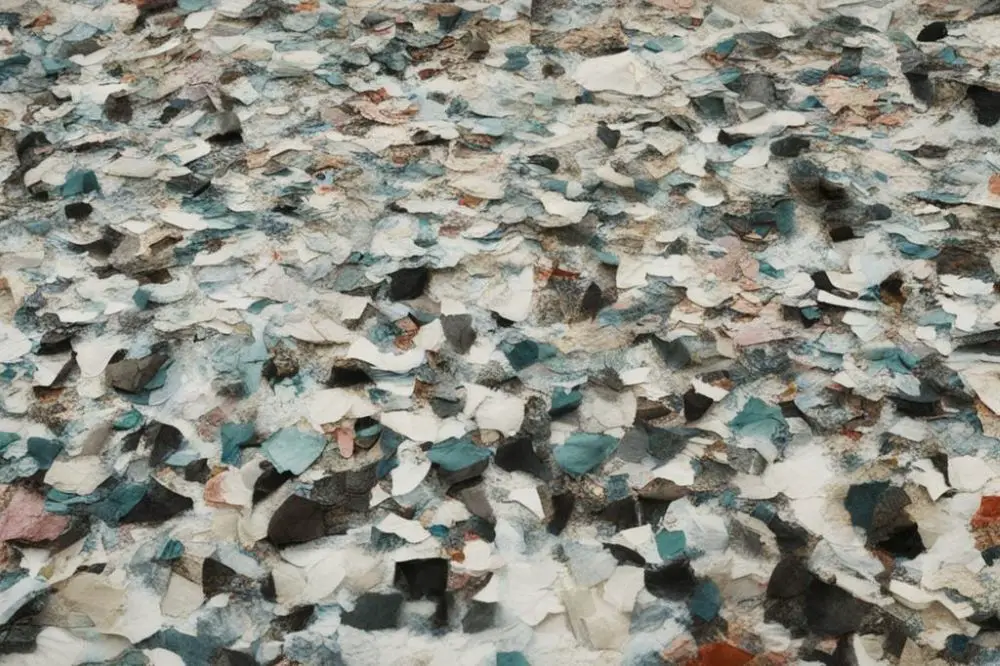
Recycled materials for stuffing offer a sustainable and eco-friendly option for teddy bear crafting, repurposing materials that would otherwise end up in landfills.
Crafters appreciate recycled stuffing materials for their environmental benefits and unique textures, making them an ideal choice for eco-conscious projects. However, like any material, recycled stuffing materials have their own set of pros and cons.
Pros:
- Environmental benefits: Using recycled materials reduces waste and minimizes the carbon footprint associated with teddy bear crafting.
- Unique textures: Recycled materials can offer interesting textures and visual effects to teddy bears, adding character and charm to each creation.
- Cost-effective: Recycled materials are often more affordable than traditional stuffing materials, making them a budget-friendly option for crafters.
- Creativity: Working with recycled materials encourages creativity and innovation, as crafters find new ways to repurpose and reuse materials in their projects.
Cons:
- Inconsistency: Recycled materials may vary in quality and texture, making it challenging to achieve consistent results across projects.
- Limited availability: Finding suitable recycled materials for stuffing may require searching through thrift stores, recycling centers, or online marketplaces.
- Cleanliness: Recycled materials may require thorough cleaning and processing to remove dirt, debris, and potential contaminants before use.
- Durability: Some recycled materials may not hold up as well as traditional stuffing materials over time, leading to potential issues with compression or degradation.
Recycled stuffing materials may be available for purchase on select online platforms such as Amazon, Etsy, and eBay, although availability may vary depending on the seller.
One example of creating stuffing material for teddy bears at home is repurposing old fabric scraps, wool roving from sweaters, and rubber foam scraps. Old clothing, linens, and fabric remnants can be shredded or cut into small pieces to create a soft and fluffy stuffing.
Similarly, wool roving can be reclaimed from old sweaters by unraveling the yarn and fluffing the fibers, providing a natural and cozy stuffing option.
Additionally, scrap rubber foam from upholstery or mattress manufacturing can be shredded or cut into small pieces to create a soft and resilient stuffing material
By repurposing these materials that would otherwise go to waste, crafters can create sustainable and eco-friendly stuffing for their teddy bear projects without the need to purchase new materials.
10. Wooden Stuffing
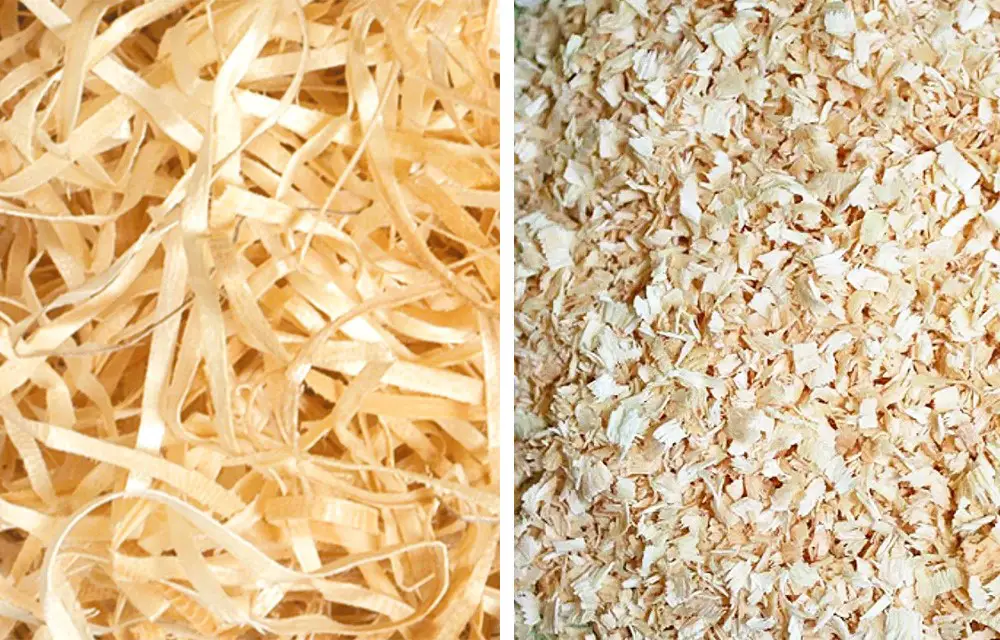
Wooden stuffing, traditionally used in classic teddy bears, offers a unique and nostalgic option for crafters seeking authenticity and durability in their projects.
Crafters appreciate wooden stuffing for its firmness and stability, providing teddy bears with a solid and substantial feel reminiscent of vintage plush toys. However, like any material, wooden stuffing has its own set of pros and cons.
Pros:
- Authenticity: Wooden stuffing reflects traditional methods used in classic teddy bear production, adding retro charm and character to handmade creations.
- Durability: Unlike softer stuffing materials, wooden stuffing provides long-term support and structure to bears, ensuring they retain their shape and integrity over time.
- Weight distribution: Wooden stuffing evenly distributes weight throughout the bear’s body, giving it a balanced and picturesque appearance.
- Preservation: Wooden stuffing can help preserve the shape and condition of vintage or collectible plush bears, preventing sagging or deformation.
Cons:
- Potential for deterioration: Modern wooden stuffing may be susceptible to deterioration, as it is a natural material that can emerge from seams over time, causing discomfort and spoiling the bear’s appearance.
- Care concerns: Using wooden stuffing may require more careful maintenance and care to prevent its deterioration and ensure the long-term preservation of the bear.
- Limited availability: Wooden stuffing may be more challenging to find compared to modern stuffing materials, requiring sourcing from specialty suppliers or vintage teddy bear restoration experts.
- Labor-intensive: Working with wooden stuffing requires precision and care, as improper installation or handling can lead to damage to the bear’s structure.
- Lack of softness: Wooden stuffing does not provide the same plushness or cuddliness as softer materials, potentially affecting the tactile appeal of the finished teddy bear.
- Weight: The added weight of wooden stuffing may make the finished teddy bear heavier and less suitable for certain applications or preferences.
Wooden stuffing may be available for purchase on select online platforms such as Amazon, Etsy, and eBay, although availability may be limited.
Crafters interested in using wooden stuffing may also consider repurposing materials from old or damaged vintage teddy bears for an authentic and nostalgic touch to their projects.
General Tips
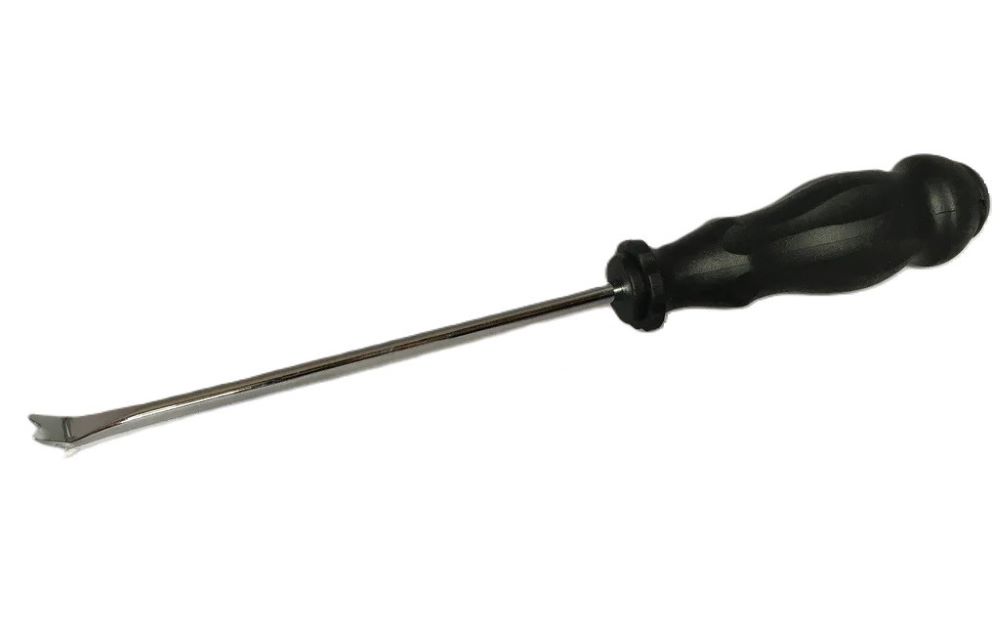
- Tools for stuffing may include:
a. Stuffing tool or chopstick: Use to push the stuffing into small or hard-to-reach areas (noses, limbs), ensuring the bear is evenly stuffed.
b. Scissors: Trim excess stuffing and thread for a clean finish.
c. Scale: Measure the amount of stuffing needed for consistency across multiple bears or projects. - Technique of stuffing:
a. Start with small amounts of stuffing, gradually adding more as needed to achieve desired firmness.
b. Distribute stuffing evenly throughout the bear’s body, paying attention to limbs and other detailed areas.
c. Avoid overstuffing, as this can lead to a stiff and unnatural-looking bear. - When purchasing stuffing for teddy bears, stuffed animals, and children’s toys online, be sure to check the product descriptions and reviews to ensure they meet your specific needs and requirements.
- Consider mixing different materials during stuffing to achieve desired textures and densities, such as combining polyester fiberfill with microbeads for a softer yet firmer feel.
- Adding weight to teddy bears can enhance their lifelike feel and stability, especially when using materials like poly pellets, metal, or glass pellets for collectible teddies. Ensure weight is evenly distributed to maintain balance.
- Consider the age and intended use of the teddy bear when selecting stuffing materials, opting for hypoallergenic and washable options for children’s toys. For collectible bears, artists often use materials like synthetics, wool roving, or organic cotton batting for a more luxurious and durable finish.
- Experiment with different stuffing materials and techniques to find what works best for your specific project and preferences.
Conclusion
In conclusion, crafting teddy bears is a delightful and rewarding experience, filled with endless possibilities for creativity and expression.
By exploring a variety of stuffing materials, techniques, and tools, crafters can bring their unique visions to life and create cherished keepsakes for themselves or loved ones.
Whether you’re a beginner or an experienced artist, the key is to experiment, learn, and enjoy the journey of teddy bear making.
Remember to consider the age and intended use of your bear when selecting materials, prioritize quality and safety, and don’t hesitate to seek inspiration from fellow crafters or online resources.
With dedication and passion, every teddy bear you create becomes a work of art, ready to bring joy and comfort to those who hold it dear.
More Goodies
- Caring for Collectible Teddy Bears: Learn essential tips and techniques for cleaning and preserving your precious collectible teddy bears to ensure they remain in pristine condition for years to come. Read more
- Exploring Different Types of Teddy Bear Fur Fabric: Delve into a comprehensive guide that explores the various types of fur fabric used in teddy bear making, from mohair to synthetic fur, and discover which is best suited for your next project. Read more
Join Us for Exclusive Content and Updates!
Are you seeking more inspiration, free patterns, tutorials, and tips for crafting adorable teddy bears? Join our Facebook page for exclusive updates, and don’t forget to subscribe through the Spotlight form towards the beginning of the article—this is your chance to access exclusive content and win teddy bear crafting supplies!
Let’s create together and share the joy of teddy bear art!

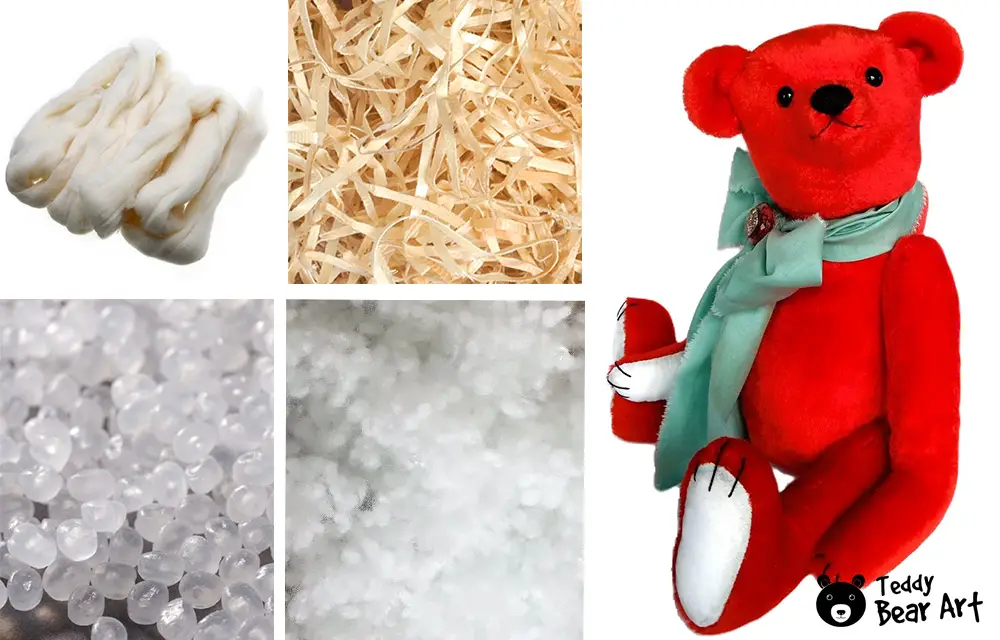
You offer invaluable information on the 10 best options for stuffing your cuddly companions. From classic cotton to eco-friendly alternatives like recycled polyester, this guide will ensure your teddy bears are not only soft, but also eco-friendly. A must read for any teddy bear lover who wants to create the perfect teddy friend! Thanks for the interesting reading!!!
Thanks a bunch for the kind words! I’m thrilled to hear you found the guide on stuffing options helpful. Making our teddy pals soft and eco-friendly is definitely a win-win!
I came on your website to learn about the options of the teddy bear stuffing material, you see my nieces do this as a hobby and sell them to earn extra money.
Wow, I never imagined there were so many options for stuffing for teddy bears. I am not sure what my nieces are using to stuff their teddy bears.
I appreciate how you provide the pros and cons for each stuffing option, this makes it much easier for people to make the best decision.
Your general tips section is another bonus reading your article, I am going to share your website with my nieces, so they can read and learn from you.
Jeff
Hey Jeff!
Thanks for stopping by and diving into the world of teddy bear stuffing materials! It’s awesome that your nieces have found a creative outlet and a way to earn some extra cash through their hobby.
I’m thrilled to hear that you found the information on stuffing options helpful. Making informed decisions is key, especially when it comes to crafting something as special as teddy bears.
Feel free to share the website with your nieces! I hope they find the tips and resources here valuable for their teddy bear adventures. If they have any questions along the way, I’m here to help!
Happy crafting!
Hanna
I love how this guide not only covers traditional stuffing materials but also explores eco-friendly options like recycled polyester, organic cotton betting and bamboo fiber. It’s great to see sustainability being prioritized in teddy bear making. Have you tried using eco-friendly stuffing materials in your projects? If so what we the results??
I’m thrilled you enjoyed the guide! Sustainability is a big deal for me too. I’ve definitely experimented with eco-friendly stuffing materials, and the results have been pretty amazing. Recycled polyester gives a fluffy feel, while organic cotton brings a natural touch. Bamboo fiber is a personal favorite for its softness. Plus, knowing we’re reducing our environmental footprint while crafting our beloved teddies just adds an extra layer of warmth to the process.